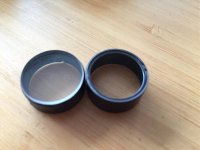Rathaus
Well-known member
Today I plucked up the Dutch courage to twist off the eyepiece from my current Swedish military Habicht with reticle. The Reticle was a fun novelty at first, but now I desire reticle free viewing.
I can say that the torque required to remove that right eyepiece by hand was unbelievable. I could guess the NM...it was crazy. I have the hands of a gorilla and i had nothing left to give. These are obviously IF. On my fourth or fifth attempt I lay them flat on a bench top with eyepiece overhanging, and gave it absolutely everything. I was bellowing like a soviet shot putter as I untwisted the thing. It finally budged. Then undid smoothly. The reticle protruded about three mil from the rest of the eyepiece housing, so I tweaked it out smoothly with some Swiss army small pliers. All went back together straight away smoothly.
I did the procedure quickly but the humidity was 60% but cool....so, as an experiment, we'll see how the right side goes. It is perfect right now.
Now I have a fresh clean view. Just beautiful. Stunning.
I also did this to my Chinese mil IF bins before turning them into monoculars for the kids (they loved them!). Same simple reticle removal procedure..but reticle was a bit rougher to remove.
Anybody done the same thing?
Cheers
Rathaus
I can say that the torque required to remove that right eyepiece by hand was unbelievable. I could guess the NM...it was crazy. I have the hands of a gorilla and i had nothing left to give. These are obviously IF. On my fourth or fifth attempt I lay them flat on a bench top with eyepiece overhanging, and gave it absolutely everything. I was bellowing like a soviet shot putter as I untwisted the thing. It finally budged. Then undid smoothly. The reticle protruded about three mil from the rest of the eyepiece housing, so I tweaked it out smoothly with some Swiss army small pliers. All went back together straight away smoothly.
I did the procedure quickly but the humidity was 60% but cool....so, as an experiment, we'll see how the right side goes. It is perfect right now.
Now I have a fresh clean view. Just beautiful. Stunning.
I also did this to my Chinese mil IF bins before turning them into monoculars for the kids (they loved them!). Same simple reticle removal procedure..but reticle was a bit rougher to remove.
Anybody done the same thing?
Cheers
Rathaus
Last edited:




